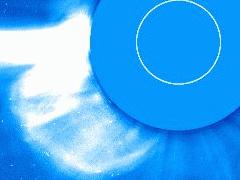 |
|
+ Home | ||

|
||||
| + Solar Cycle Prediction | + Magnetograph | + The Sun in Time | + The Hinode Mission | + The STEREO Mission |
Solar Wind Features
|
Magnetic CloudsMagnetic Clouds are produced in the solar wind when solar eruptions (flares and coronal mass ejections) carry material off of the Sun along with embedded magnetic fields. These magnetic clouds can be detected in the solar wind through observations of the solar wind characteristics - wind speed, density, and magnetic field strength and direction. | ||
Corotating Interactive RegionsCo-rotating Interactive Regions (CIRs) are regions within the solar wind where streams of material moving at different speeds collide and interact with each other. The speed of the solar wind varies from less than 300 km/s (about half a million miles per hour) to over 800 km/s depending upon the conditions in the corona where the solar wind has its source. Low speed winds come from the regions above helmet streamers while high speed winds come from coronal holes. As the Sun rotates these various streams rotate as well (co-rotation) and produce a pattern in the solar wind much like that of a rotating lawn sprinkler. However, if a slow moving stream is followed by a fast moving stream the faster moving material will catch-up to the slower material and plow into it. This interaction produces shock waves that can accelerate particles to very high speeds. Composition VariationsThe chemical composition of the solar wind has several interesting aspects that hint at physical processes that occur in the solar wind source regions. The solar wind composition is different from the composition of the solar surface and shows variations that are associated with solar activity and solar features. This page is under construction - more content and links to follow | |||
